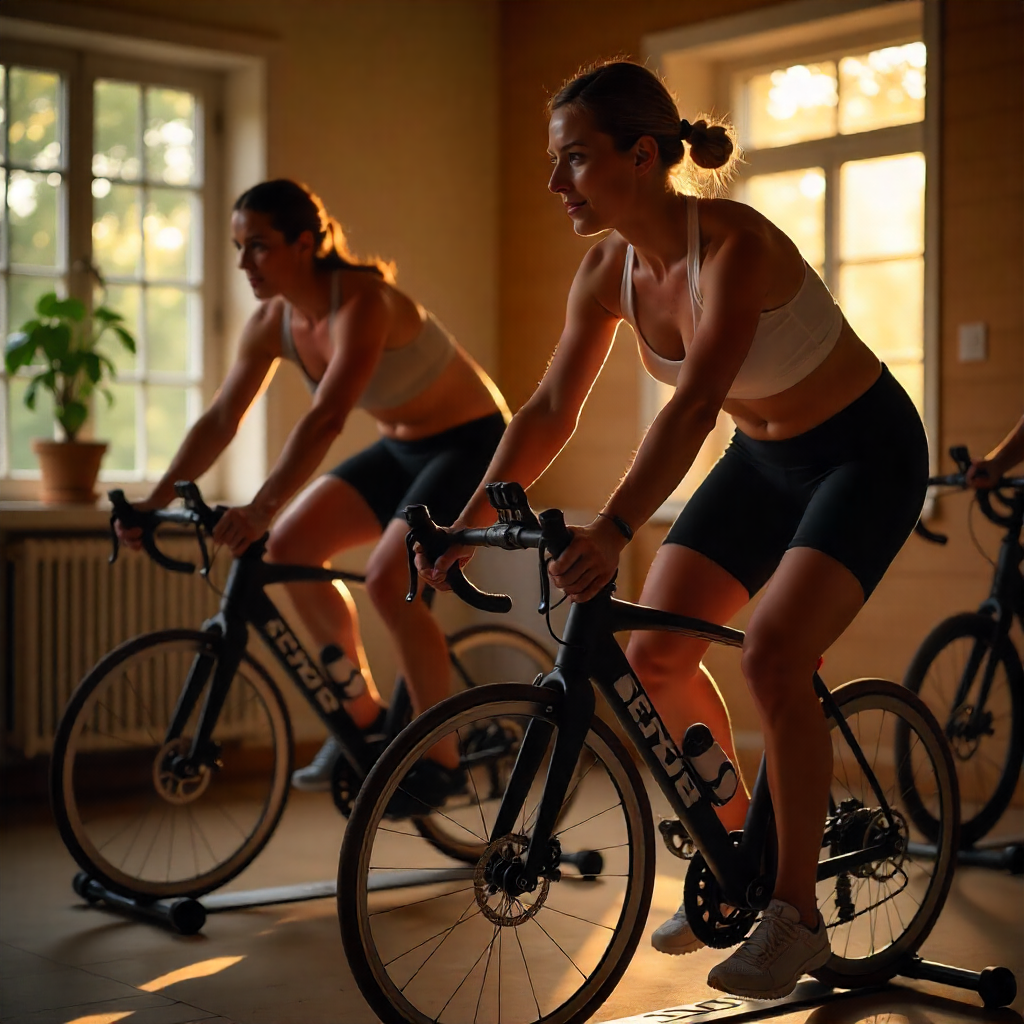The Best Fluffy Pancakes recipe you will fall in love with. Full of tips and tricks to help you make the best pancakes.
Indoor Cycling Injuries : How to Avoid Them
Discover common indoor cycling injuries and learn practical prevention tips to ride safely, avoid pain, and stay consistent.

You’re halfway through an intense indoor cycling session, legs burning as you power through another climb interval. The music is pumping, your heart rate is soaring, and you’re feeling invincible – until that sharp twinge shoots through your knee. You try to push through it, telling yourself it’s just part of getting stronger, but by the end of the ride, you can barely walk without wincing. Sound familiar? We’ve all been there. That moment when our enthusiasm for crushing workouts collides with the harsh reality of poor form, improper setup, or simply doing too much too soon. What started as an energizing fitness routine suddenly becomes a source of frustration and pain. You find yourself wondering if indoor cycling injuries are serious, or if you’re doing something fundamentally wrong that’s sabotaging your progress.
The truth is, indoor cycling shouldn’t leave you injured or chronically sore when done correctly. While this low-impact exercise is generally safer than many other activities, ignoring proper technique, bike setup, or recovery can lead to preventable injuries that derail your fitness goals. In this post, we’ll explore six of the most common injuries that indoor cyclists face – from knee pain and lower back strain to neck tension and saddle sores. More importantly, we’ll give you simple, practical strategies to prevent each one. No complicated jargon or expensive solutions – just straightforward tips that any rider can implement immediately to stay healthy while training harder.
Knee Pain: The Most Common Indoor Cycling Injury
Knee pain ranks as the top complaint among indoor cyclists, often manifesting as patellofemoral pain or IT band irritation that can sideline your training for weeks. Poor bike setup creates the perfect storm for knee problems, with saddle height being the primary culprit. When your saddle sits too low, your knee joint experiences excessive compression at the bottom of each pedal stroke. Conversely, a saddle positioned too far forward shifts your weight incorrectly, forcing your knees to track improperly throughout the pedaling motion. Excessive resistance during climbs or sprints compounds these issues, especially when combined with poor cleat alignment that forces your knees into unnatural positions.
Prevention starts with proper saddle adjustment – ensure a 25-35 degree bend in your knee at full leg extension. Keep your knees tracking straight throughout each pedal stroke, avoiding inward collapse or outward bowing. Check your cleat position regularly and avoid grinding heavy resistance for extended periods. Focus on smooth, controlled pedaling rather than forcing power through poor positioning.
Lower Back Pain: When Poor Posture Takes Its Toll
Lower back strain affects countless indoor cyclists who unknowingly compromise their spinal alignment during intense sessions. The aggressive forward position required for indoor cycling places significant stress on your lumbar spine, particularly when your bike setup forces you to overreach for the handlebars. Poor posture compounds this problem as riders tend to round their backs excessively, creating pressure on spinal discs and surrounding muscles. Weak core muscles fail to provide adequate support for your spine during high-intensity efforts. Tight hip flexors from prolonged sitting pull on your lower back, creating additional tension that builds throughout your ride.
Proper bike fit prevents most lower back issues – ensure comfortable reach with slight elbow bend when gripping handlebars. Maintain neutral spine alignment throughout your ride, avoiding excessive rounding or arching. Incorporate core strengthening exercises like planks and dead bugs into your weekly routine. Regular hip flexor stretches counteract tightness from prolonged cycling position.
Neck and Shoulder Strain: Tension That Builds Silently
Neck and shoulder strain creeps up on indoor cyclists who maintain excessive upper body tension during their rides. Gripping handlebars too tightly creates a chain reaction of tension that travels up your arms into your shoulders and neck. Poor posture with slouched shoulders forces your neck into an unnatural position to maintain forward vision. Handlebars positioned too low or too far away require you to crane your neck uncomfortably throughout the entire session. This sustained tension becomes particularly problematic during longer rides or high-intensity intervals when you naturally tighten up.
Relaxation is key – maintain a soft, loose grip on your handlebars throughout your ride. Keep your shoulders down and back in their natural position, avoiding the tendency to hunch forward. Occasionally stretch your neck and shoulders between intervals to release accumulated tension. Adjust handlebar height and reach to maintain comfortable upper body positioning without straining to reach forward, and avoid indoor cycling injuries.
Saddle Sores and Numbness: Painful Contact Point Issues
Saddle sores and numbness represent some of the most uncomfortable problems indoor cyclists face, often developing gradually before becoming debilitating. Poor saddle fit creates pressure points that irritate soft tissue during repetitive pedaling motions. Incorrect saddle height or angle forces excessive weight onto sensitive areas, restricting blood flow and creating friction. Long rides without position changes compound these issues as sustained pressure builds on the same contact points. Sweaty conditions create the perfect environment for chafing and bacterial growth. The confined nature of indoor cycling eliminates natural position shifts that occur during outdoor riding.
Quality padded cycling shorts or bibs provide essential cushioning between your body and the saddle. Apply chamois cream to reduce friction at contact points during longer sessions. Adjust your saddle angle slightly downward, aiming for neutral or negative one degree. Stand up or shift your position every 10-15 minutes during extended rides to relieve pressure and restore blood flow.
Foot Numbness and Hot Spots: When Your Feet Revolt
Foot numbness and hot spots plague indoor cyclists who ignore proper footwear fit and cleat positioning during their rides. Shoes that fit too tightly restrict blood circulation, leading to tingling sensations that worsen throughout your session. Misaligned cleats force your feet into unnatural positions, creating pressure points on your forefoot or arch. Excessive pressure concentration on the ball of your foot during high-intensity efforts causes burning sensations. Poor pedaling technique with improper foot positioning exacerbates these problems. Inadequate arch support allows your foot to collapse, changing pressure distribution across the pedal surface.
Slightly loosen your shoe straps and check for pressure points against your insoles. To avoid indoor cycling injuries, invest in stiff cycling shoes with proper arch support to maintain foot stability. Adjust your cleats to avoid excessive toe-in or toe-out angles that stress your foot position. Ensure your foot sits naturally on the pedal without forcing unnatural angles.
Hand and Wrist Pain: Upper Body Discomfort During Rides
Hand and wrist pain develops when indoor cyclists place excessive weight on their handlebars throughout extended sessions. Leaning too heavily on your hands creates sustained pressure that compresses the median nerve, leading to numbness and tingling. Handlebars positioned too low force you into an aggressive position that increases weight distribution to your upper extremities. Repetitive pressure on the same hand positions during long rides creates cumulative stress on your wrists and palms. Bent wrists under load strain the delicate structures in your forearms and hands.
Change your hand positions regularly throughout your ride to distribute pressure differently. Raise your handlebars slightly if you find yourself leaning too heavily on your hands. Use padded gloves or handlebar tape to cushion contact points and reduce vibration. Keep your wrists in neutral alignment, avoiding excessive backward bending that strains your joints and prevent indoor cycling injuries.
Overtraining Injuries: When More Becomes Less
Overtraining injuries manifest as chronic fatigue, joint inflammation, and declining motivation that signal your body’s inability to recover from training stress. Too many high-intensity sessions without adequate recovery overwhelm your body’s adaptation mechanisms. Skipping rest days prevents necessary tissue repair and glycogen replenishment. Poor sleep quality and inadequate nutrition compound recovery deficits, creating a downward spiral of declining performance. Ignoring early warning signs leads to more serious overuse injuries and burnout.
Follow a periodized training plan that incorporates recovery rides and complete rest days into your weekly schedule. Monitor your resting heart rate or heart rate variability to track recovery status objectively. Ensure adequate caloric intake to support your training demands and prioritize quality sleep for optimal recovery. Listen to your body’s signals and adjust training intensity when fatigue accumulates.
Summary
Indoor cycling offers incredible fitness benefits, but only when you prioritize proper technique and injury prevention. The seven common injuries we’ve covered – from knee pain and lower back strain to overtraining fatigue – are entirely preventable with the right approach. Focus on proper bike setup, maintain good posture, and listen to your body’s signals before minor discomfort becomes major problems.
Remember that consistency beats intensity when building long-term fitness. Take time to adjust your position, incorporate recovery days, and address any pain immediately rather than pushing through it. Your body will reward smart training with better performance and fewer setbacks.
For more guidance on avoiding common training pitfalls, check out our comprehensive guide on indoor cycling mistakes that can derail your progress. Smart preparation and proper technique will keep you pedaling strong for years to come, injury-free and motivated to reach your fitness goals. and avoid indoor cycling injuries.






[…] listen to your body — and talk to your doctor if needed. This post pairs well with our guide on common indoor cycling injuries and the recovery routine in cooling down after a ride. Together, they’ll help you stay consistent […]
[…] With the right recovery plan like in Cooling Down After a Ride and smart injury strategies from Common Indoor Cycling Injuries and How to Prevent Them, your rides can feel smoother and more empowering than ever. Keep building momentum, stay […]
[…] With indoor cycling, there’s no pressure to “keep up.” It’s all about your personal ride, on your terms.If You want to read more about how to stay safe on the trainer, check our last post about How To Prevent Injuries […]
[…] By the end of this guide, one thing is clear: your goals are the compass. Choose the bike that aligns with your vision of health, and your indoor cycling journey will become not just effective—but truly enjoyable.Check our latest posts about What To Eat Before Spin Class and How To Prevent Injuries […]